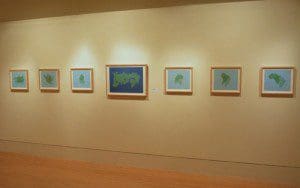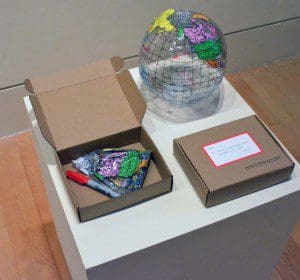Our Earth has never been more divided. Tensions between the United States and other major powers like Russia and China, as well as conflict in the Middle East, cast a shadow over a planet threatened by climate change. Not to mention that the current run-up to the 2016 presidential election has begun to seem less like a political race and more like a professional wrestling match. But what if there was a way to heal our world’s divide–both figuratively and literally? Through a revolutionary geo-engineering process, the Political Tectonics Lab–pioneered by experimental philosopher Jonathon Keats–is proposing a plan to direct the movement of our continents into the most politically and economically ideal arrangement, in a project titled Pangaea Optima.
Some 250 million years ago, the continents were locked together in one massive supercontinent dubbed Pangaea. Although the original Pangaea eventually broke apart and became the individual land masses we know them as today, scientists predict that the continents will one day form back together…in another 200 million years, that is. Of course, the trouble of waiting for nature to take its course is that the trajectories of Mother Nature are often all too random. Who’s to say just where North America will end up when this Pangaea takes shape?
Addressing that very question in late October Keats unveiled his prototype “diplomatic geoengineering technologies,” as well as preliminary mapping for Pangea Optima, at the Modernism Gallery in downtown San Francisco. Zyzzyva was in attendance on that most auspicious and rather misty evening as a crowd gathered–some skeptics among them–to witness the debut of this rare scientific project that could have ramifications for mega-annums to come.
Keats was brimming with enthusiasm and quick to stress the urgency of his mission: “What we need is Pangaea Optima, and we need it fast.” The scientist posited that it is, in fact, “geographic coincidences” that give individuals their conflicting perspectives, and that by forging another planet-spanning landmass the citizens of the Earth could rally on a common ground that is more than mere metaphor. Would the world’s powers be so quick to drop bombs if there was no such thing as “foreign” soil?
Of course, one can’t expect to change the movement of the very ground beneath our feet overnight. The Political Tectonics Lab’s plan involves building nuclear reactors to plug into the rifts on the ocean floor, locally cooling the magma and “intelligently managing subcrustal heat” in order to control the movement of the continents. Unsurprisingly, such a colossal undertaking is sure to ruffle feathers in the scientific community, and even seemed to give pause to some present at the Modernism that night.

A member of the crowd posed the question: Considering all the polarizing issues that San Francisco is currently facing, including rapid gentrification and a growing homeless population, why should the citizens of the Bay Area–let alone the world–turn their gaze to an event that will be some 200 million years in the making? Keats acknowledged the rampant dilemmas gripping the nation at the moment, but voiced his belief that the scientific community is perfectly capable of focusing on the problems of the future without ignoring the problems of the present.
Addressing a possible role for the tech industry, which many believe is currently directing the future of San Francisco for better or ill, Keats remained optimistic. “You could see Pangaea Optima as an opportunity for redemption on the part of the tech world,” Keats asserted. “Techies like a challenge. I think it’s why they got into that business to begin with.” Keats believes the unconventional nature of developing technology that has to function for millions of years could lead to a company such as Google having to develop new problem-solving strategies. “That might then result in a different approach to other problems Google has either conjured,” Keats continued, “or even genuine problems they are seeking to solve,” leading to a positive impact on the community at large.
To the delight of those in attendance, he also suggested that going about the process of directing Pangaea’s formation very slowly could allow mankind to eliminate earthquakes altogether, constituting a concrete advantage of Pangaea Optima aside from improved relations among the nations of the world.
And yet there remains another hurdle: How, exactly, to finance what will undoubtedly be an expensive undertaking? As is the case with most every scenario, Keats does not suffer from a lack of ideas. He underscored the irony that the technology his group is constructing could be licensed out to fracking companies to prevent the very same tremors their practices are creating. Since it’s unavoidable that forging the continents into a giant landmass will severely alter the planet’s bodies of water, Keats envisions generating funds by offering entities the opportunity to purchase naming rights for the new lakes and such created by Pangaea Optima. When pressed, Keats conceded the potential for too much corporate control by seeking out financial investors from the private sector: “There is enormous risk of too much control,” he stated, but was quick to point out that the 200 million-year-time table of Pangea Optima is a “built-in mechanism” that will most likely prevent any “harmful attempt to control the actual shape of the future planet.” The Political Tectonics Lab actually anticipates many corporations being eager to contribute if only to help “greenwash” their reputation.
Keats stressed that the Political Tectonics Lab is not attempting to fight nature or halt the progress of evolution. Rather, Keats argues that Pangea Optima is merely an attempt to “counteract ourselves,” to rectify–at least in part–the disastrous efforts of a human race that has devastated the planet’s resources and spent the 20th century flirting with global annihilation. And while it may be a tad optimistic to expect a proposition for Pangaea Optima to appear on the ballot in 2016, Keats said he certainly hopes Pangaea becomes a political issue. Pangaea’s potential impact is so far-reaching that politicians could scarcely ignore it; and yet Keats suggested that Pangaea Optima is “totally outside the scope of politics as usual,” as its formation is not beneficial to some group of people at the detriment of another, and the payoff won’t exactly be arriving within voters’ lifetimes. Pangaea requires a commitment to what Keats calls “a long-term universalistic thinking that would be very much at odds with pretty much anything Donald Trump has said.”
All the same, Keats is the first to admit that Pangaea Optima remains “an extraordinary act of hubris that should give us all pause.” Keats acknowledged that the operation opens the door to a number of contingencies–leaving room for error or the potential for disaster. “This is why I’m not in this room alone,” Keats said. In the spirit of collaboration, the Political Tectonics Lab is open to alternative continental arrangements for Pangaea Optima. To that end, the Lab distributed Pangaea kits to those in the audience. The kit included an inflatable globe and a Sharpie marker with which amateur geographers can design their own optimal layout for a possible Pangaea. Lastly, the kit includes a shipping label for sending the resulting design to the United Nations as they weigh the option to support the Political Tectonics Lab’s mission. (Faithful readers of Zyzzyva can look forward to the opportunity to chart their own Pangaea in a future issue of the magazine arriving sometime in 2016.)
As the event came to a close, the patrons were left to collect their swirling thoughts, dispose of their wine glasses, and venture out into the brisk San Francisco evening. (The Pangaea Optima plans will be available for viewing by appointment through December at Modernism.) This intrepid reporter pulled the collar of his jacket high against the crisp air and dispersed into the bustling city streets, where one thought kept returning to the forefront of his mind. While buses roared past, conversations brewed, and traffic lights flickered, I lingered on Jonathon Keats’ singular credo: that even as we turn our heads to geological events some two hundred million years in the future, the 21st century could immeasurably benefit if all of us simply became more imaginative in the way we look at the world.



A most fascinatiing read regarding Keats Pangea Optima and one wonders how long it will be before tectonics does indeed become a poitical football…sometime in the next 200 million years.